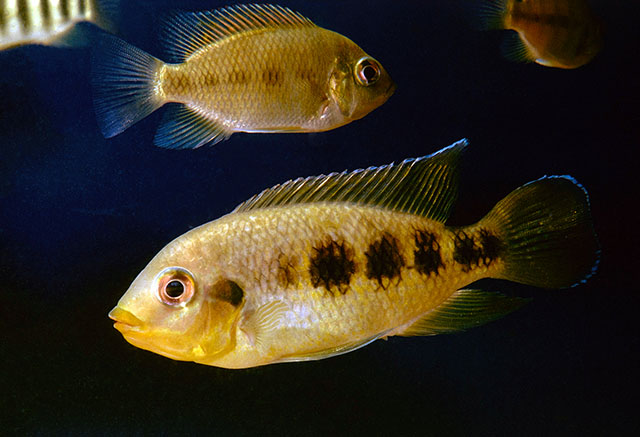| Cichlidae (Cichlids), subfamily: Pseudocrenilabrinae |
| 32.3 cm SL (male/unsexed); max.weight: 1,360.0 g |
|
demersal; freshwater; brackish; pH range: 6 - 8; dH range: 5 - 19, |
| Africa: coastal lagoons and lower river courses from the Tabou River (Côte d'Ivoire) to the Kribi River (Cameroon), but absent from the area between the Pra River (Ghana) and Benin (Ref. 53405). Also recorded from the lower Ntem, Cameroon (81260). |
|
Dorsal spines (total): 15-17; Dorsal soft rays (total): 13-15; Anal spines: 3-3; Anal soft rays: 10-11. Diagnosis: body rather elevated (body depth 46.9-51.6% SL) (Ref. 53405). Head profile rounded (Ref. 81260). Outer teeth on jaws bicuspid (Ref. 53405), gracile (Ref. 81260) and spatulated (Ref. 53405, 81260). Lower pharyngeal jaw teeth relatively small and narrow near posterior border of bone, forming an almost felt-like covering (Ref. 81260). Micro-gillrakers present; adults (> 150 mm) with a series of dark blotches in the middle of the flanks (sometimes body entirely blackish) (Ref. 53405, 81260). Juveniles with 7-9 large vertical bands (Ref. 53405). Ventral scales with central red spot; 12 or more rakers on lower limb of first gill arch (Ref. 81260).
Description: head length 29.7-34.7% SL; 3-6 rows of teeth on both oral jaws, outer row teeth bicuspid and spatulate (Ref. 81260). Lower pharyngeal bone as long as broad, length of toothed part 46.9-55.7% of total bone length (Ref. 53405). Anterior pharyngeal teeth tricuspid (Ref. 53405, 81260) and strongly recurved (Ref. 81260), posterior pharyngeal teeth bicuspid (Ref. 53405, 81260) and straight (Ref. 81260), not broadened (Ref. 53405). Scales cycloid (Ref. 53405). Eyes located in a very anterior position; frontal profile concave; caudal fin slightly rounded, with a small notch (Ref. 52307).
Coloration: in life: juveniles: ground colour yellowish; belly whitish, sometimes reddish, back and top of head brownish-yellow (Ref. 53405, 81260). Sides and caudal peduncle with 7-9 (Ref. 52307, 53405, 81260) broad, brownish-black cross bars (Ref. 53405, 81260). Dark bar on occiput and gill cover and another one between eyes and on cheek; dorsal, anal and caudal fins yellow-brown, showing same pattern of bars as on body, anal fin darker distally; pelvic fins yellowish, their anterior margins brownish (Ref. 53405, 81260). Adults have 2 different colour patterns: 1) back, sides and fins entirely black, with very narrow red edge along upper margins of dorsal and caudal fins 2) spotted pattern consisting of yellow ground colour becoming greenish on back and olive-green on top of head (Ref. 53405). In both forms, belly white; sides and caudal peduncle with 5-6 distinct mid-lateral black spots, more close-set on caudal peduncle; scales on sides below midline often with central red spot; unpaired fins greenish, with numerous light red spots between soft rays (Ref. 53405, 81260). Blue fringe, edged by narrow red band on distal margins of dorsal and caudal fins (Ref. 53405, 81260), and occasionally all around caudal fin (Ref. 53405). Pelvic fins greenish, darker on anterior margin (Ref. 53405, 81260). |
| Live in still or flowing waters in rocky or mud-bottom areas (Ref. 44894). Occur in warm springs and mud-bottomed to sand-bottomed canals (Ref. 5723). Clearly prefers a herbivorous diet, including algae, higher plants and parts of cassava, but also accepts insects and shrimps (along with their eggs) (Ref. 52307). Consume plant matter. Reache sexual maturity at 10-15 centimeters length. Parents prepare nest site on logs, leaves and other debris. Prolific species (Ref. 52307). The eggs (600-3300 per female) are guarded by the parents and hatch in 1-3 days. Larvae need 6-8 additional days to develop before they can swim freely (Ref. 52307). Parental care of the brood continues until the fish are about (1.5 cm, Ref. 52307) 2.5-3.0 centimeters (Ref. 44894). Occurs in mixed groups composed of individuals of varying size/age, along with individuals of other species (Ref. 52307). Pair-bonding, open (Ref. 52307) substrate brooder (Ref. 52307, 81260) with both parents guarding the brood (Ref. 52307). Maximum size was recorded at 39.4 cm TL (Ref. 40637). |
|
Least Concern (LC); Date assessed: 16 October 2019 Ref. (130435)
|
| harmless |
|
Source and more info: www.fishbase.org. For personal, classroom, and other internal use only. Not for publication.

